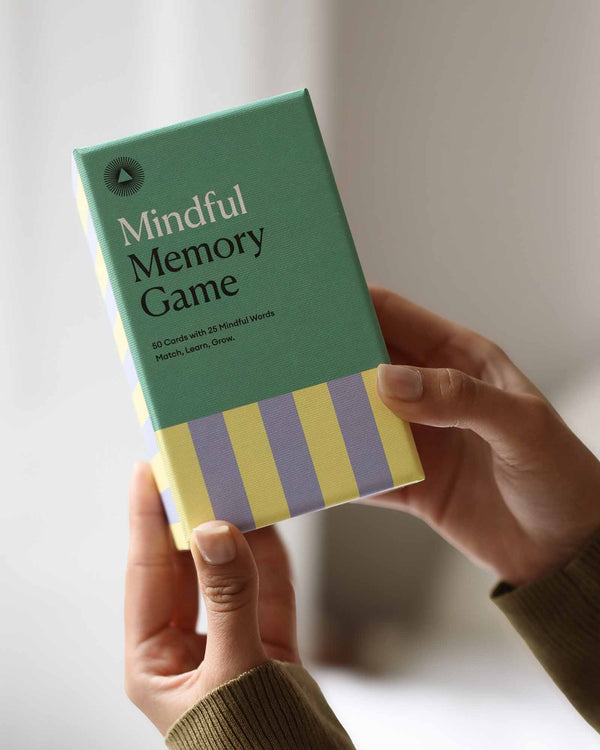Five Minute Journal App Tips
by Kevin Evans
Below you will find 8 tips to get the most out of The Five Minute Journal App including best practices and ways to avoid getting stuck.
CONTENTS
1. The Most Important Tip for Sticking With The Five Minute Journal2. Get Specific!!!
3. Using Categories: How Tim Ferriss Uses The Five Minute Journal
4. This is How You Really Make Your Day Great
5. How to Write Effective Affirmations
6. How to Do an Amazing Review of the Day
7. Using The Five Minute Journal to Learn & Improve Every Day
8. Why Do You Use The Five Minute Journal
TIP #1: The Most Important Tip for Sticking With The Five Minute Journal App
It may seem simple but...
To build the habit of using the Five Minute Journal App consistently, the most important decision you can make right now is to set and turn on notifications.
To do so, click the circle icon in the upper lefthand corner (your profile photo if you set it) and navigate to preferences:

Do it now (or as soon as you’re able) - set the notification times for morning & night. You’ll be glad you did. That’s it.
In a few days, we’ll share the second most important tip: it matters less what you write and more what you experience and feel.
TIP #2: Get Specific!!!
We have heard from numerous Five Minute Journalers that, at times, it can feel repetitive. People get tired of writing the same old stuff they are grateful for each day. What to do?!
We say,
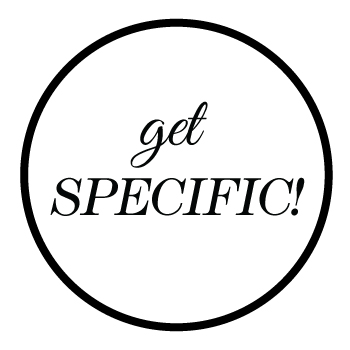
When doing the Five Minute Journal it matters less what you write; it matters more what you experience and feel.
Thinking of a list of things to be grateful for usually comes rapidly, but the feeling typically takes a bit longer to kick in. Waiting for the emotion--the wonder and awe--before putting pen to paper makes all the difference.
The more detailed you can get while writing what you are grateful for, the easier it is to connect with the emotion.
Think about novels. Typically, authors do not just generally describe something, they get into detail. Novelists do not just say, “he drove a car,” they say, “he drove a black Mustang that sounded like it held a grudge".
For example, today you write, “I am grateful for John.”
Do you actually feel good writing that down? If not, get specific. What is it about John that makes you grateful?

Do the same with the "3 Amazing things that happened today..." section:
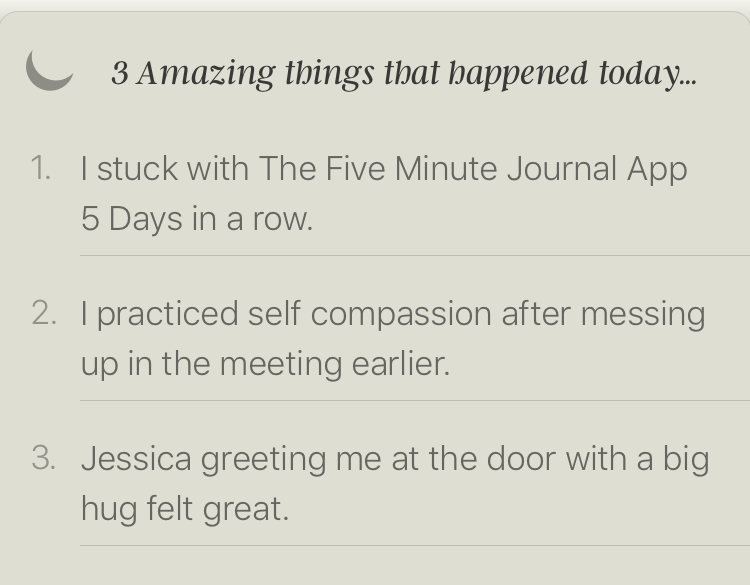
Now pause for a moment. How do you feel with what you wrote down? Are you connecting with it? If not, try writing something new until you do. If you connect with it, then congratulations! It’s time to move on.
If you do not rush through writing your gratitudes and take a few extra moments to dig deeper, you will see much greater and lasting results. The more you practice this, the easier and quicker this process will become.
TIP #3: Using Categories: How Tim Ferriss Uses The Five Minute Journal
In previous tips, we talked about the importance of connecting with what you write down in the Five Minute Journal. No connection/feeling to what you are grateful for = no bueno.
Despite knowing this tip and having the best intentions to write soul fulfilling gratitudes, you will inevitably face “gratitude block.” From here you have a choice. Either quickly write a meaningless gratitude (world peace!), take longer to write so you connect (but I have to get out the door for work!) or option 3.
What is option 3 you ask?
It’s how Tim Ferriss (best-selling author of the 4 Hour Work Week, 4 Hour Chef and 4 Hour Body) uses the journal. He’s a type-A personality who finds the Five Minute Journal quite useful to practice gratitude and start the day on the right note.
So how does Tim use the Five Minute Journal?
Instead of thinking of random gratitudes each day, Tim single tasks the Five Minute Journal a la categories.
Tim uses 4 categories:
1. Relationships: An old relationship that really helped you
2. An opportunity that you have today
3. Something great that happened or your saw yesterday
4. Something simple near you (clouds outside, pen you are holding, etc)
Instead of trying to color with every gratitude crayon in the box, he uses a few. What if today you just focused on relationships you are grateful for? Or things you are grateful for about your health?

We usually find that having a day where we select a "category" to focus on helps generate gratitude ideas quicker. Thanks Tim!
If you get stuck in the Five Minute Journal, pick one singular focus and use the Five Minute Journal solely dedicated for that day, week, or month.
TIP #4: This is How You Really Make Your Day Great
When great things happen unexpectedly during the day, month, or year it’s easy to feel…great. It could be a friend writing you a thank you letter, winning tickets to a concert, or finding twenty dollars in your jacket. Feels pretty darn good!
A problem arises if you expect random great things to happen in order to make your day great and they never come:

You can, however, focus on taking tiny daily actions that increases the likelihood of making your day great.
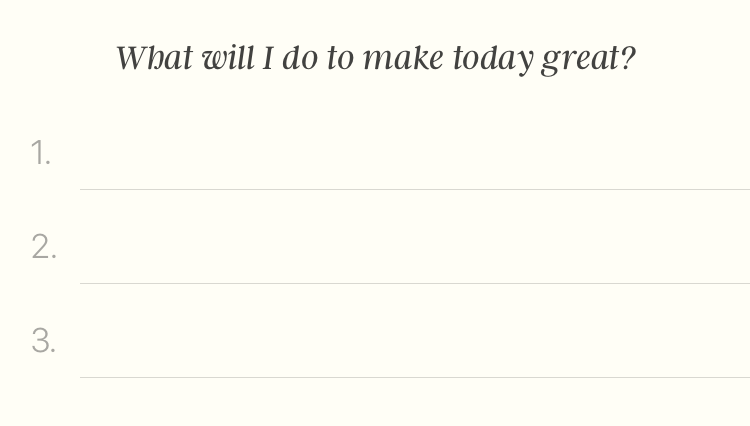
How many times prior to doing the Five Minute Journal have you asked yourself, “what would make today great?” Imagine creating a consistent “cycle of great things” like this:

It’s like a chain reaction:
- Focus on smiling more → more people being warm and friendly too you → more friendships randomly appear.
- Focus on going to gym → become more attractive → more dating opportunities randomly appear.
- Focus on meditating → become more calm → more patient people randomly appear.
Of course, the process is not linear, but in general, the more action you take towards making your day great, the greater likelihood random great things appear. In sociology, they call this the Matthew Effect (or accumulated advantage), the phenomenon where "the rich get richer and the poor get poorer."
So how do you actually make your day great?
Do you know that spent, fulfilled feeling you get when you finish an amazing day? Aim for this. If it helps, close your eyes and project yourself to the end of the day, imagining and visualizing the things that would have happened if you were feeling that feeling.

You could just as easily do the reverse of this, focusing on the action first and then identifying the feeling behind it. The cheat-sheet here = I will do (tiny action), because I want to feel (emotion):

These actions do not need to be earth shattering. The key is to keep them tiny enough so you actually complete them. They can be as simple as “tell my wife I love her”, “get outside today,” or “smile at the barista today.”
When first filling out this question, you may write a bunch of action items that you thought would lead to satisfying day, but in reality did not. That’s ok! Over time you will get better at identifying the things that make your day great and thus answering this question becomes much easier. Your progression will look a bit like this:
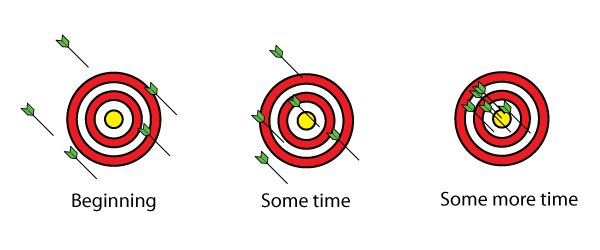
If thinking of 3 great things each day seems overwhelming, focus on ONE thing for the day--one thing that if completed would leave you satisfied with your day. Quality trumps quantity here.
What if the "what would make today great" section gets repetitive or you consistently fail to do any of the items you write down?
If I am building a new habit (such as meditating, starting a new workout, developing new social skills), odds are I will have the same action items several days/weeks in a row. As long as I keep feeling fulfilled from completing that task at the end of the day, it stays. If it begins to feel empty and meaningless, I reassess what I write down.
As Leonardo Da Vinci said, “A well spent day brings happy sleep.” Now go and make your day great!
TIP #5: How to Write Effective Affirmations
I have learned writing daily affirmations is probably the most misunderstood part of The Five Minute Journal.
There is more to affirmations than wishing for a million dollars and hoping the universe will magically deliver it to you. So we need to get the basic principles straight.
First, I will talk about the foundation and purpose of this section before moving on to some tactics.
THE PURPOSE: Work at the edge of your reality
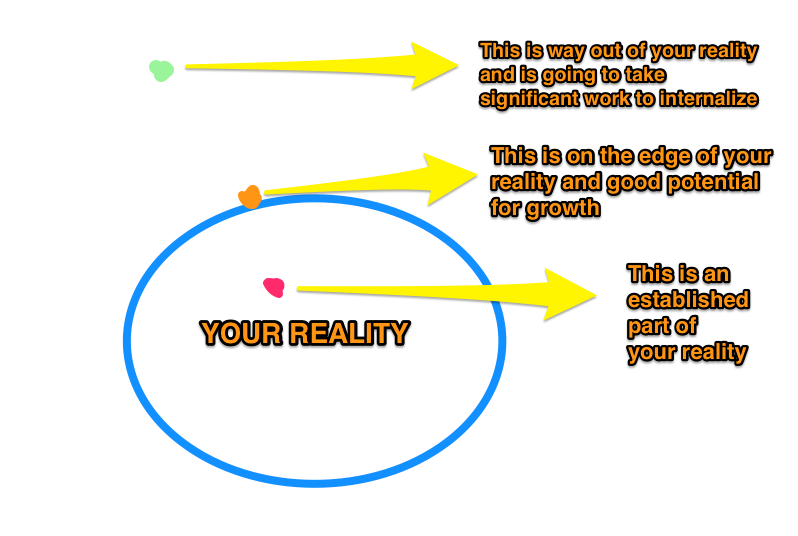
Let’s take an example of an eager Five Minute Journaler. Meet Cole.
Cole is an entrepreneur who started a couple of successful product-based businesses.
If he were to write the affirmation, “I am excited to create great products that help people”, that is very much in his current reality (the pink dot).
If he were to write the affirmation, “I am pumped to grow my businesses by 50% this year”, that might be at the edge of his current reality (the orange dot).
If he were to write the affirmation, “I am honoured to be the industry leader in sustainable growth products”, that would be significantly outside his current reality (the green dot).
In general, the purpose of an affirmation is to push the edges of your reality. You want it to be around the orange zone. If you are comfortable stretching the edges of your reality significantly, then go green.
The litmus test of how good your affirmation is depends on how do you feel after you write it.
Do you believe it? Do you feel better? If so, you’re on the right track.
Do you feel worse? Chances are you’re biting off more than you can chew.
Do you feel neutral? Chances are you’re not thinking big enough.
From here, there are two tactical ways to write affirmations.
THE TACTICS: The Hammer and the Butterfly Approach
1. The Hammer Approach - This is where you pick an affirmation that you want to deeply integrate into your life and you write it in your journal every day. The more often you write it, the deeper you integrate the strength of that belief within yourself. I find this technique works well for me.
We call it the hammer approach because you basically hammer in one affirmation until you truly experience the benefits and it has become part of your life.
For example:
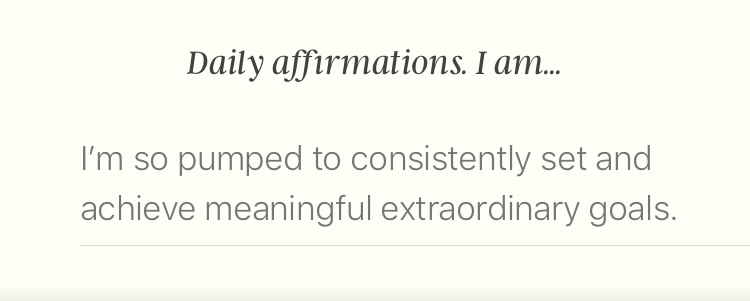
2. The Butterfly Approach - This is where you make up your affirmation on a daily basis. You affirm a part of your reality you want to see more of - maybe you have a presentation later in the day and you want to write this:
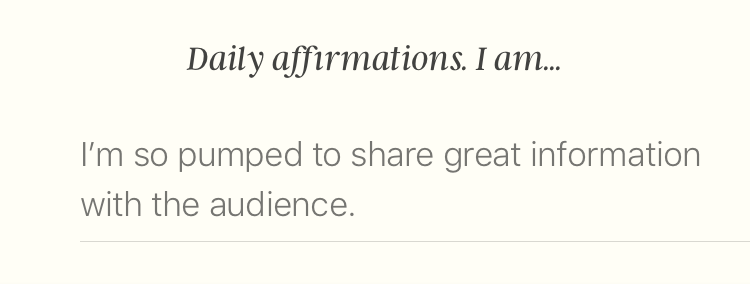
Basically, you let your feelings that day or what you have planned to guide your affirmations.
Whatever approach you choose can work well and I recommend picking one and sticking to it.
In summary, choose an affirmation that is at the edge of your current reality and then use either the Hammer or Butterfly Approach to write in your affirmation. Remember, the litmus test is how you feel as you write your affirmation as a compass for progress.
TIP #6: How to Do an Amazing Review of the Day
Every night when we open my Five Minute Journal I see this question:

Here’s the thing. If the day was incredible, the section will write itself.
But if the day sucked, you might feel conflicted when you hit this question. The aim of this email is to resolve that conflict. Let’s take an example.
Say Alice finishes a sub-par day with many distractions at work, traffic delays, and a cancelled meeting she was looking forward to.
What is she going to write in her Five Minute Journal!?

As entrepreneur and motivational speaker Jim Rohn said, “Don’t wish it were easier, wish you were better.”
The important thing to understand here is that ‘amazing’ does not necessarily mean buying your dream house or finding your life partner.
It can also mean that the stoplight turned green at just the right time or the barista flashed you a wonderful smile. If you truly look for it, you will find amazing moments in your day. Sometimes an amazing moment can be avoiding a problem or conflict. That too is a success. The “things could have been a whole lot worse” scenario.
When Alice first looks at the “3 Amazing things that happened today…” question, she first thinks, ”Nothing amazing happened today”. That is just the first layer of the mental response. She knows that there are more layers and all she needs is a little more time to get to dig a little deeper and get to the good stuff.
Alice starts to review her day from the moment she woke up, looking for nuggets of amazing moments. It takes her some time, but she remembers three wonderful moments and jots them down:
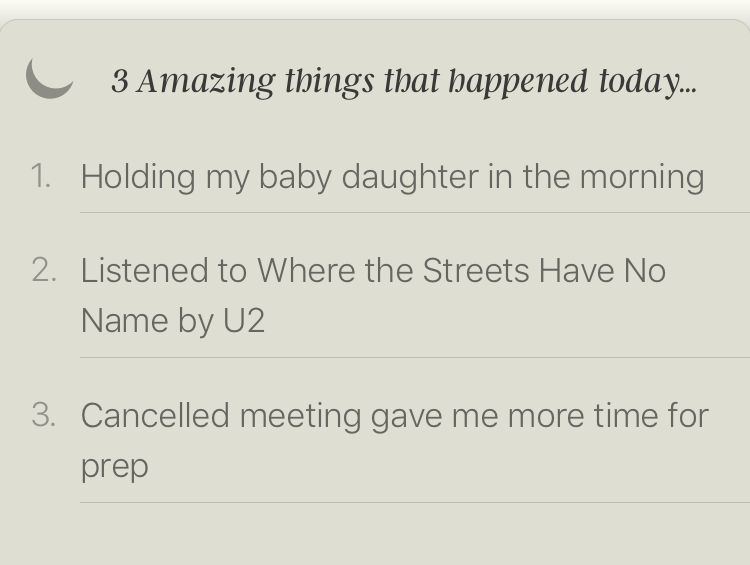
The critical factor here is connecting with what you write down. As per a previous Five Minute Journal tip email, the more specific you get, the easier it will be to connect with the emotion. Keep going with finding the amazing moments and you will find some great ones.
TIP #7: Using The Five Minute Journal to Learn & Improve Every Day
When you read the following question:
The question Five Minute Journalers say they struggle the most with is:
“How could I have made today even better?”
When your day went poorly, reflecting further on what you could have done better can add to the already brewing tsunami of stress.
You intended to have a happy productive day but then you browsed Buzzfeed instead of compiling your presentation, you skipped your healthy lunch for a food-truck special that left you feeling bloated and you took the frustrations of your day out on your partner. Even your dog was avoiding you.
When you see that last question, you may think, “What could I have done better!?! I could have not been such a giant lazy “________”.
On the flip side, if your day went well, you may feel it kills your vibe. “Haven’t I done enough already???”
What are you to do?
Framing “How could I have made today even better?”
We are not going to deny that the last question is a bit uncomfortable. That’s intentional.
The ability to analyze your day, your week, or your life and identify recurring unhelpful patterns, attitudes, and behaviors is the key to psychological breakthroughs. Taking responsibility and tweaking these areas helps us create a more meaningful life.
Having filled out, “How could I have made today even better” for years, we’ve learned we are often too close to ourselves to not be overly critical when answering it. After all, we know our inner deep secrets and the chaos of darkness we are capable of. That’s a lot to bear psychologically. Our expectations of success may be a wee bit too high.
We’ve learned it helps if we imagine ourselves as a friend giving us advice and treating ourselves like someone we are responsible for helping.
Gaining this distance allows us to be more objective and thus, lessen the overwhelming negative emotions that may accompany reflecting on how we could have improved our day.
From the “friend giving advice frame”, we then ask ourselves what’s the smallest conceivable action we can do to improve upon tomorrow?
To that end, it requires us to cast a critical eye and pick a moment we thought we could slightly tweak that helps us improve our behavior. Remember, actions speak louder than words.
Answering “How could I have made today even better?”
Let’s say you packed and intended to eat a kale salad today for lunch but instead you felt stressed at work and a co-worker offered to buy you McHappy Meal. You then ate a Big Mac, fries, and a Coke. You felt awful afterward, both physically and mentally, for failing to carry out your goal of eating “healthier.”
A weak answer to “How could I have made today even better” would be, “Eat healthier.” This response, while well intentioned, gives you no useful information to change your behavior, and thus habits, going forward. There is nothing actionable there.
Stronger answers may include:
- “Form a plan or something to say to my co-workers to turn down their ‘unhealthy’ lunch offers.”
- “Try a different ‘healthy’ lunch recipe other than a salad tomorrow.”
- “Identify the ‘ingredients’ of what leads to stress at work and why I then default to ‘unhealthy’ foods.”
All these answers pinpoint specific actions or behaviors you could try that could tip the odds in your favor of adopting healthier eating habits.
Another example.
Let’s say you got into a heated argument with your partner about them not sharing equal responsibility for taking your Dachshund puppy to do his business. Instead of the conversation going constructively, it went quickly south and descended into name calling and covering the entire history of problems in your relationship. Yikes! Luckily, you both were able to resolve things before going to bed, but the underlying tension from the argument remains.
When looking at the last question, a weak answer to “How could I have made today even better” may be, “Not being an a-hole.” Shame typically begets shame causing a downward spiral, the opposite of what we want. Not helpful.
Stronger answers may include:
- “Tell my partner I want to continue the conversation, but need some time to cool off by taking a short walk.”
- “Listen to my partner and self-reflect and realize that maybe you are kind of lazy and they have a point.
- “Bring up the issue up in a different context/tone/time of day/when I am in a better mood.”
- See walking the pup as a chance to do something together and have an extra moment in the day to chat.
Again, answering these questions are not always easy and finding a specific behavior to tweak may require a bit of digging.
Here are some more rapid fire ones:
- Always late to work in the morning? Maybe you need to lay your clothes out the night before.
- Can’t find the time to exercise? Park a little further from the door and take the stairs.
- Failed to write the novel of the century? Try writing late at night vs first thing in morning.
Constantly tweak. Constantly experiment. You need to break a lot of eggs to make an omelette.
Avoiding the question altogether.
Psychologist and mediation teacher Tara Brach wrote this wonderful paragraph in her book Radical Acceptance:
“If we have been traumatized in the past, old feelings of terror may be triggered. We might not have the balance or the resiliency in a particular moment to meet our experience with unconditional friendliness, and our attempt at yes might actually end up flooding us with fear. It would be better instead to find a way to alleviate the fear, perhaps by seeking comfort with a friend, doing vigorous exercise or taking prescribed medication. For the time being, saying no to what feels like too much, and yes to what simply works to keep us balanced, is the most compassionate response we can offer ourselves.”
Sometimes you’ve had one of those days where it looks like the world is caving in and nothing went well.
While we gently urge you to pass push through your discomfort and analyze what you could have done better, sometimes the burden is just too much to bear.
On these days, the most compassionate response you can give yourself may be to not fill out the question. The litmus test here is if you constantly skip it, ask yourself if you are avoiding the question because it’s genuinely overwhelming or the self-analysis and reflection is just too uncomfortable.
The other time you may choose not to write a response is if you had one of those amazing days where you feel on top of the world. Simply drawing a smiley face is perfectly acceptable. A win is a win!
As an alternative, on good days, simply stating you want to double down on what you did today is also cool!
TIP #8: Why Do You Use The Five Minute Journal
Gym owners love January 1st. That is when SO many people come, pay for the year, and never set foot back in the place. Ever.
Replace the gym with practically any new behavior change--learning a new language, meditating, or learning an instrument. People get all excited in the beginning, but somewhere along the way, enthusiasm fades and the exciting new hobby is dropped.
We do not want that to happen to you with the Five Minute Journal!
In the beginning of the Five Minute Journal we ask you to write why the habit is important to you. The section is short and only gets three lines but quite frankly it is the most important section.
Do you want to become more grateful? Why?
Do you want to become happier? Why?
Do you want to become more positive? Why?
Getting clear on your "why" will make all the difference.
It is the fuel that keeps up the Five Minute Journal habit when times get tough and you do not feel like doing it. Think of the gym again. You drag yourself there after a long day but feel amazing after.
Let us compare and contrast:
- A: The Five Minute Minute Journal is important to me because I want to be more grateful.
- B: The Five Minute Journal is important to me because it allows me to be more present, loving, accepting with my family, and show up as a father.
With B, we can feel the reason. We can see the reason. We believe the reason. It is clear.
Another fine example:
- A: The Five Minute Journal is important to me because I want to be happy.
- B: The Five Minute Journal is important to me because I want to make the best out of the cards I was dealt in life. I want to celebrate life and live with joy rather than seeing the world with a cynical, glass-half-empty attitude like the environment I grew up in.
With B, we can feel the deep-seated beliefs and emotions associated with being unhappy. It is much more meaningful than a vague “I want to be happy.”

If you do not actually believe the Five Minute Journal can change your life, it will not. It will just be another project that sits on the shelf collecting dust. Become engaged. Positive change awaits you if you make the effort.









